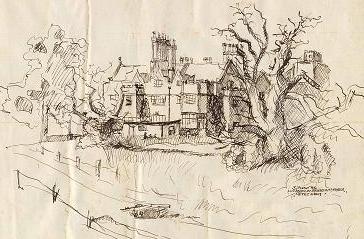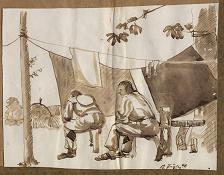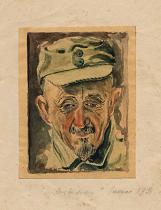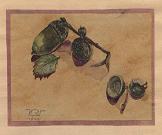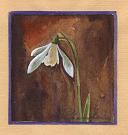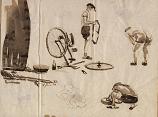
Wilhelm Rubenbauer, b1916 – d1993 |
|
 |
|
|
Little is known about the war time history of the prisoner of war camp once sited at the Dignus Tile factory. A chance email to the Madeley website in early 2005 requesting any information or photographs of the camp, initiated a quest to find out more about Madeley’s role in housing captured prisoners of war. 24th February, 2005 Dear Mr. Finney, Perhaps you will be surprised to receive this e-mail from Germany. May I introduce myself before asking your assistance. I am librarian at Bayreuth University Library. Apart from dealing with books and media I am also responsible for organizing exhibitions showing interesting items of our rare book collection or presenting paintings and drawings of local artists. Early in May we are going to present a twin exhibition with paintings of a middle-aged artist (Berthold Rubenbauer, b. 1951) and drawings of his late father (Wilhelm Rubenbauer, 1916-1993). Wilhelm Rubenbauer was actually a china painter by profession. During World War II he was taken prisoner and spent four years (1944 to 1948) as POW in England. About Christmas time in 1945 he was lucky to receive a paint box by the Red Cross and he made good use of it. He drew his comrades, scenes of camp life and a few landscapes. Being released he managed to take his drawings and paintings home to Germany. His son still preserves them. The original inscriptions on Wilhelm Rubenbauer’s drawings and paintings helped us to identify the POW-camp he belonged to. It must have been Camp 193 i.e. Madeley Tile Works Camp. Apart from Madeley there is a drawing that refers to Addersley and another one that shows Shrewsbury cathedral. I wonder if you could provide any further information concerning Madeley Tile Works Camp ? Some drawings show a tar boiler. That is why I assume that the POWs had – at least sometimes – to repair roads or streets. Do you know who ran the camp ? Have you a picture of the camp commandant by any chance ? There is just one portrait amongst Rubenbauer’s sketches and drawings. According to Rubenbauer junior it shows the commandant. I don’t think so, as the man in the picture is wearing a German army cap. A neat drawing shows a three-gabled house with a row of chimneys on top of the roof and two turrets in front of the building. Old trees suggest that the house was situated in a garden or park. The German inscription says “red house”. Could my description enable you to identify the building? Was it possibly the manor house? I am looking forward to your reply. With best wishes across the Channel |
|
| Auszug aus Biografie von Willi RubenbauerGeboren 1916 in Ebnath, gestorben 1993 in Brand/ Opf.
Nach seiner Schulzelt ging er in die Lehre um das Glas – und Poizellanmalerhandwerk zu erlernen. Nach der Lehre ware sein Traum ein Studium an der Kunstakademie gewesen. Doch nach der Ausbildung kamen Arbeitsdienst, Krieg und kurz vor Ende des Zweiten Weltkrieges die vierjährige Gefangenschaft. – In einer alten Ziegelei in England waren ca. 1500 bis 2000 deutsche Gefangene inhaftiert. In den ersten Tagen dürfen sie nicht arbeiten, so dass ihnen das Warten zur Qual wird. Da zieht es einen Soldaten wieder zu seiner alten Leidenschaft hin, dem Malen. So wurden zum Beispiel alte herumliegende Zementsäcke nass gemacht, in kleine Stücke zerrissen und über Heizungsrohre gezogen, so dass sie, auf diese Weise glatt gemacht, sich einigermaßen zum Malen eigen. So kann er sich am Anfang zumindest die lange Zeit des Wartens mit Bewegungsstudien und Skizzen aus dem Lagerleben ausfüllen Weihnachten 1944. Insgesamt sechs Malkästen mit je sechs Farben werden von Roten Kreuz an die gefangenen Soldaten verteilt. Willi Rubenbauer ist unter den Glücklichen, einen davon zu erhalten. Was er damit macht, kann man nur annähernd begreifen, wenn man sich JEDES einzelne Bild sehr lange anschaut und sich über jeden Strich, über jede Schattierung, Gedanken macht. Was muß in dem Menschen vorgegangen sein, der so übergenau beobachtete und auch das winzigste Detail nicht ausser acht ließ.- So entstanden die Bilder. – Erinnerungen aus meiner Gefangenschaft- |
Excerpt from the Biography of Willi Rubenbauer Born 1916 in Ebnath, died 1993 in Brand Opf. He went to school to learn about hand painted glass and Porcelain. After this learning period his dream was to study at the academy of arts. But before completion of his studies he was called to war duty. He was captured shortly before the end of the Second World War and spent the next four years imprisoned. In an old brickyard in England were approx. 1500 to 2000 German fellow prisoners. In the first days they were not allowed to work, so boredom set in. While there, it drew this soldier again to his old passion, painting. Lying around were cement bags that when soaked in water, torn up into small pieces and pulled over heating pipes to remove any creases could be used to produce artwork. Now there was something to fill out the long wait, motion studies and sketches from the camp life. Christmas 1944. Six paint boxes with six colours in each are distributed to the imprisoned soldiers by the Red Cross. Willi Rubenbauer is lucky enough to receive one of them. He makes good use of it. You can only have a brief understanding, even if you look at each individual picture for a very long time, over each line, over each shade, Think about it. What must have been the thoughts of the man, who observed so fastidiously and did not ignore the tiniest detail? Thus the pictures developed. Memories from my term of Imprisonment |
|
Finding the Trail It had been known that there was a prisoner of war camp in Madeley Heath but different accounts gave differing locations, although putting it in the general area of the tile and brick works. Personal accounts pointed to various local areas so it was just a matter of finding the exact location. Added to this are accounts of Italian POW’s detraining at Baldwins Gate railway station and marching to the camp at Madeley. One wonders why this would be the case when the station in Manor Road Madeley is much closer! It is possible that to prevent any conflict, they were marched across the fields thus avoiding the centre of the village altogether. A trip to Newcastle under Lyme Borough Museum turned up nothing, no records exist there of any POW camp in the area. Using the words ‘Madeley’ and ‘prisoner of war’ in a search engine provided a list of known POW camps in the U.K. Looking at the list provided the what was the exact number for the Madeley Heath camp, number 193. Some records incorrectly show the camp being in Madeley, Shropshire! The bonus from the list was the name ‘Adderley Hall’ which provided the clue to the other camp mentioned in the email and shown as Addersley. A trip to Adderley looked like the trail had gone cold when it was discovered that the hall no longer exists after being demolished in the early 1960’s because of rot from constant mopping of the wooden floors. Fortunately a local resident had several photographs and documents relating to the demolished building. Not having spare copies, the documents were photographed using a digital camera and a brief study showed a suspiciously familiar sight, the multiple grouped tall chimneys! A check against Herr Rubenbauer’s sketch of the Rotes Haus – (Red House) confirmed this along with the design of the bay windows. The location of the second POW camp that Wilhelm Rubenbauer was held in had been found, Adderley Hall. It was now possible to identify from this information along with the dates on the sketches and paintings the area where they had been produced. Time in Madeley The painting Lager 193 – Kommandant od. Aufseher – Camp 193 (Madeley Heath) Custodial Commander shown in the left column, correctly gives the number assigned to Madeley Heath POW camp. Additionally, the artwork is a colour painting therefore we can determine that sometime between Christmas 1944 & July 1946 Herr Rubenbauer was transferred to Adderley Hall camp. From Herr Rubenbauer’s account it is obvious that most of the waking hours at Madeley Heath were spent trying to find tasks to occupy idle hands and minds and a rudimentary yet ingenious method of producing sketching paper had been devised. From his account, Willi tells of receiving paints from the Red Cross on Christmas 1944 adding to his ‘collection’ of art materials which he put to good use. It is possible that the prisoners were not allowed out to work until after the allied victory in Europe, after which it was felt safe enough to provide work in and around the countryside so any distraction would be welcome before this. Time in Adderley What is known from the date 3rd June 1946 on one of the paintings that Herr Rubenbauer had been moved to Adderley Hall, Camp 192. After being allowed a limited amount of freedom, Herr Rubenbauer’s sketches show a variety of activities including, tarring the roads, angling and even bicycle riding, although it isn’t clear whether the riders were in fact the prisoners themselves. Two sketches are listed as Shrewsbury England, so whether it was a trip to a hospital or for work purposes, the prisoners weren’t confined to the camp all of the time. As with the war years and families in the area inviting American servicemen for Christmas dinner, so the same courtesy was offered to the prisoners once V.E. day had passed. After release some stayed on, married local girls and settled in their adopted land not perhaps wishing to return to the ruins of the Fatherland.
Adderley Hall
Return Home In 1948 Wilhelm Rubenbauer was repatriated back to his family in Germany. His son Berthold Rubenbauer, was born in 1951. More about Wilhelm Rubenbauer is unknown but what he left was a legacy of some beautiful artwork of the Staffordshire and Shropshire area, produced during a period when the world was in turmoil and conflict. It also gives an unique insight into camp life during the period he was held captive.
|
|
Berthold Rubenbauer son of Wilhelm Rubenbauer, followed in his father’s footsteps and has painted many pictures. View them on his very own website.

